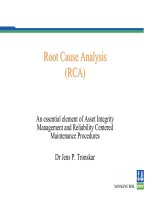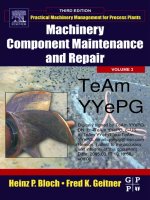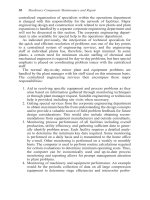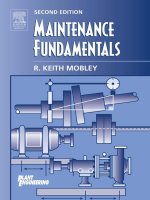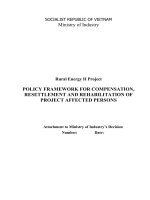Maintenance Policy
Bạn đang xem bản rút gọn của tài liệu. Xem và tải ngay bản đầy đủ của tài liệu tại đây (235.13 KB, 13 trang )
Issue No. 1 Issue Date: 9/1/03
M
AINTENANCE
P
OLICY
P
ROPERTY
A
ND
F
ACILITIES
D
IVISION
T
HE
U
NIVERSITY
O
F
Q
UEENSLAND
Issue No. 1 Issue date: 9/1/03 Page 1
P
ROPERTY AND
F
ACILITIES
M
AINTENANCE
P
OLICY
1.0 INTRODUCTION
The University of Queensland owns and uses an extensive portfolio of land and building assets in
delivering its teaching and research programmes. This document provides a policy and
management framework to ensure that these assets are maintained appropriately to support the
University’s strategic objectives. The deterioration of buildings due to lack of maintenance can
lead to future financial burdens, pose legal and other industrial relations issues and affect the
delivery of teaching and research.
2.0 OBJECTIVES
The objectives of this policy are to:
• clarify maintenance responsibilities for land and building assets;
• specify the minimum requirements for the management of maintenance;
• ensure that assets are adequately maintained;
• ensure that associated risks are effectively managed;
• ensure that land and building assets perform effectively and efficiently throughout their
service life;
• appropriate decisions are made in selecting maintenance strategies;
• ensure that a sound basis exists for the allocation of maintenance funds.
3.0 SCOPE AND RESPONSIBILITIES
Property and Facilities Division (P&F) generally is the sole provider of maintenance services for
University-owned facilities. As the University is the owner of land and building assets, P&F is
responsible for:
(a) acting as ‘building owner’ in respect of asset management and compliance with statutory
and regulatory building requirements;
(c) the maintenance and repair of the plant, equipment and services set out in Column 2 of
Schedule 1 of this document.
Facilities that fall outside P&F’s responsibility are :
• facilities not owned by the University;
• some domestic residences;
• Student Union Facilities;
• UQ Staff and Graduates Club;
• Private child care centres.
Building occupants are responsible for:
• Ensuring that facilities are kept in a safe and tidy condition;
• Reporting building related faults to P&F Works Control Centre;
• Funding building related work that falls outside the scope of this maintenance policy.
Issue No. 1 Issue date: 9/1/03 Page 2
4.0 POLICY
4.1 Preamble
Maintenance funds will be used to achieve the greatest benefit for University buildings and
associated infrastructure. Within the constraints of available resources, University facilities will be
maintained to the best standard possible while meeting statutory obligations and the operational
needs of the University community. Choosing between the many competing demands on these
maintenance funds is a difficult and demanding task, especially in a climate of increasing costs
brought about by factors such as more stringent legislation, rapid growth in the building stock,
extended academic programmes and the increasing ratio of research space to teaching space.
Maintenance funding is prioritised within budget levels and will be allocated in consideration of the
following factors:
• Statutory compliance.
• Workplace health and safety.
• Risk management.
• Asset life cycles.
• Impact on teaching and research programmes.
• Public appearance.
• Property loss/damage.
4.2 Maintenance Standards
Each facility will be allocated an Importance Rating of 1- 5 (refer AAPPA Guidelines for Strategic
Asset Management). Maintenance standards will vary depending on the importance of the facility
as per the guide below:
1 Not important Carry out only essential maintenance
2 Low importance Defer non-essential maintenance where possible
3 Fair importance Carry out maintenance based on risk assessment
4 Important Maintain to the best standard that resources allow
5 Very important Maintain to a very high standard
In relation to rating 5, there will always be some buildings and facilities which, because of their
importance, their prominence, aesthetic value or historical significance, must be maintained at a
higher standard than that prevailing elsewhere in the University.
Issue No. 1 Issue date: 9/1/03 Page 3
4.3 Maintenance Strategies
In delivering maintenance services, P&F will structure their activities to ensure workplace health
and safety is not compromised and disruptions to University activities are minimised where
practicable. Maintenance work is made up of the following categories:
• Preventive maintenance (PM) is maintenance which is carried out to prevent an item
failing or wearing out by providing systematic inspection, detection and prevention of
incipent failure. PM is usually programmed.
• Statutory maintenance is when plant such as lifts, fire systems, fume hoods and air
conditioning systems are serviced and maintained in accordance with legislative
requirements.
• Corrective maintenance can be defined as maintenance that is required to bring an item
back to working order when it has failed or worn out.
• Backlog maintenance is maintenance that is necessary to prevent the deterioration of an
asset or its function but which has not been carried out. The University’s backlog
maintenance liability is estimated each year by P&F. An annual Deferred Maintenance
programme has been set up to address high priority backlog maintenance items. The
Deferred Maintenance programme is normally used to replace building elements that are at
an end of their life cycle e.g., air conditioning systems, leaking and rusted roofs etc.
4.4 Funding Responsibilities
P&F are responsible for funding building repairs and maintenance that is due to fair wear and tear.
Where possible, maintenance work resulting from misuse and vandalism will be charged to the
appropriate party.
Work identified as legitimate maintenance items will be prioritised and programmed within funding
levels. Building occupants may choose to fund maintenance work if they require the work sooner
than normal maintenance programmes can provide.
Appendix A illustrates how building works are normally funded.
4.5 Facilities Condition Assessment
A facilities condition audit will be carried out on University owned facilities each year. Audits will
be carried out in accordance with AAPPA “Guidelines for Strategic Asset Management – How to
undertake a Facilities Audit, Edition 1 : October 2000”. Where resources are available, audits will
be carried out as follows:
Level 3 Detailed audit
Level 2 Walk through audit
Level 1 Desktop audit
Each facility should undergo a Level 2 or Level 3 audit every 5 years and a Level 1 audit each
intervening year.
Issue No. 1 Issue date: 9/1/03 Page 4
Building maintenance deficiencies will be identified and placed on appropriate works programmes
(eg. Corrective Maintenance, Deferred Maintenance, Rehabilitation, Capital Management Plan,
Minor Works etc.).
4.6 Maintenance Procurement
All statutory and preventive maintenance services will be procured in accordance with the
Queensland Government State Purchasing Policy. Form PF212 (Attachment A) is to be used for
tender evaluation of maintenance service contracts. These contracts are to have measurable
performance indicators established and performance reviews carried out on at least a quarterly
basis. Service contracts will be bundled so as to achieve optimum market value and reliability of
service.
Deferred Maintenance projects are tendered in the open market in accordance with the State
Purchasing Policy.
Corrective Maintenance is predominantly carried out by P&F staff. Private contractors are also
used for specialist work or for where internal resources cannot deliver the work within a reasonable
timeframe.
4.7 Maintenance Priorities
All works requests received by the Works Control Centre are assigned a priority rating. The Works
Control Centre determines the priority based on information received from the requestor. Priorities
are allocated by the category the work requested falls into.
Each priority has a response time which has been outlined below. A response time is the time it
takes maintenance to first respond to the work request and is not the actual work completion time.
Completion of a work request may be affected by a number of factors, for example, parts may need
to be ordered, or equipment may need to be taken to another location for repair. Response and
completion times may also be affected by the volume received by a trade, for example, during the
summer months refrigeration can receive over 2000 work requests.
Remember you may not see the trades staff respond to your request due to the type and location of
the work.
Priorities are listed on a 1-4 rating, with 1 being the highest priority and 4 being the lowest priority.
Table 1 below is a list of each priority with the categories outlined.



